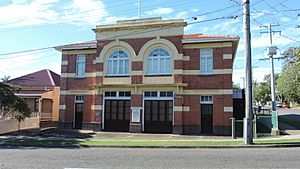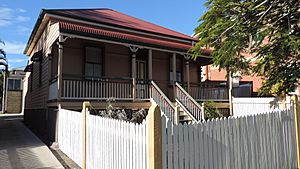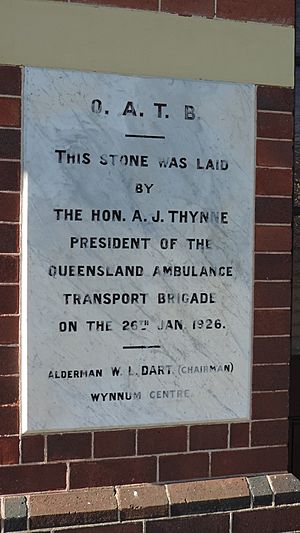Wynnum Ambulance Station facts for kids
Quick facts for kids Wynnum Ambulance Station |
|
|---|---|

Wynnum Ambulance Station, 2014
|
|
| Location | 33 Tingal Road, Wynnum, City of Brisbane, Queensland, Australia |
| Design period | 1919–1930s (interwar period) |
| Built | 1926–27 |
| Official name: Wynnum Ambulance Station (former), QATB Station | |
| Type | state heritage (built) |
| Designated | 26 March 1999 |
| Reference no. | 601778 |
| Significant period | 1926–27 (fabric) 1920s–1990s (historical) |
| Significant components | residential accommodation – superintendent's house/quarters, ambulance bay, residential accommodation – housing, garage |
| Lua error in Module:Location_map at line 420: attempt to index field 'wikibase' (a nil value). | |
The Wynnum Ambulance Station is a special building in Wynnum, Queensland, Australia. It used to be an ambulance station but is now a museum. It's called the Queensland Ambulance Museum and is a "heritage-listed" site. This means it's an important historical building. It was built between 1926 and 1927. You can visit it by making an appointment.
Contents
History of Ambulance Services
The former Wynnum Ambulance Station is a very important building. It shows how much the community supported the ambulance service. It also proves how much the ambulance service relied on local people. This included their kindness, money, and the hard work of volunteers.
Early Ambulance Care
In the early days of Brisbane, the police helped people who had accidents. From 1884, the Defence Ambulance Corps also started to help.
In September 1892, a group of people decided to form the City Ambulance Transport Brigade (CATB). This happened after a bad accident at a horse race. Their main goal was to give first aid and take sick or injured people to the hospital. Their first office was in the Courier Building in Brisbane. This was the first ambulance service in the world to pay its staff.
More and more people started using the ambulance service. The money they got from donations was not enough. So, in 1895, the Queensland State Government agreed to help. They would give the same amount of money that the public donated.
First Ambulance Buildings
The first building made just for an ambulance service in Queensland was built in 1897. It was in Wharf Street, Brisbane. This building set the example for how future ambulance stations would look. It was a two-storey building. The ground floor had space for vehicles and staff. The top floor was a home for the ambulance superintendent. Big doors on the ground floor allowed horses and buggies to leave quickly.
Between the late 1890s and early 1900s, the ambulance service grew a lot. New centres opened in many towns across Queensland. These included Charters Towers (1900), Townsville (1900), and Rockhampton (1901).
In 1902, the ambulance group changed its name. It became the Queensland Ambulance Transport Brigade (QATB). This was to help manage the fast-growing service. New main offices were set up in Ann Street, Brisbane in 1910.
By 1921, the design for ambulance stations became very clear. They were usually two-storey buildings. The ground floor had space for ambulances, first aid, and a meeting room. It also had sleeping areas for ambulance workers. The superintendent's home was on the top floor. This design was good because the superintendent was always close to their work. It also saved money by having everything in one building.
The government continued to help the QATB. The Department of Public Works designed and built many ambulance stations. In 1991, the QATB changed again. It became the Queensland Ambulance Service (QAS).
Wynnum's Ambulance Service
Wynnum is a town by Moreton Bay in south-east Brisbane. In the 1840s, it was a popular place for fishing. Many early settlers also started farms there. A railway line came to Wynnum in 1888. This helped the area grow quickly. Wynnum became known as a seaside resort. Many people visited for day trips and holidays.
People thought Wynnum was a "healthy" place to live. It had sea breezes, nice beaches, and fresh local food. As more people moved there, new services and buildings were added. Community groups also started.
The Wynnum ambulance service began in 1915. A first aid tent was set up on the beach. It helped holidaymakers during Easter and Christmas.
As the main ambulance station in Ann Street grew, smaller branches opened. These were in nearby towns and linked to the railway. Wynnum was a good spot for a new ambulance station. It was a busy area and had a train link to Brisbane. The Wynnum branch started in 1919. They first used a small house on Tingal Road. The Wynnum Ambulance Station covered a large area. This included places like Lytton and Redland Bay.
In 1920, the Wynnum Ambulance Committee bought land at the corner of Tingal Road and Cedar Street. This was a great spot, close to the railway and the main road. This land would later be where the new station was built. By 1921, Wynnum became its own ambulance centre. In 1922, they moved to a cottage at 35 Tingal Road. The front porch of this cottage was used for storage and treating patients. A garage for the ambulance was built behind the new land.
In the early days, many ambulance volunteers were school teachers. Stretchers were kept at Wynnum Central School. When someone needed an ambulance, they would call the school. The teachers would put the patient on a train. Ambulance workers from Brisbane would then meet the train at South Brisbane Station.
Wynnum was growing fast, and the old ambulance setup was not big enough. In 1923, the Wynnum community started raising money for a new station. They wanted it on the Tingal Road and Cedar Street corner. The community was very excited. They held parades and carnivals to raise money. By the time the foundation stone was laid, they had raised a lot of money.
The foundation stone was laid on January 26, 1926. Christina Jane Thynne did the honours for her husband, Colonel Andrew Joseph Thynne. He was the first President of the QATB. She shared his message that an ambulance service was a key part of every town in Queensland.
The new ambulance station cost £3284/19/1 to build. It officially opened on November 19, 1927. The Department of Public Works gave £750. The rest of the money was raised by the Wynnum community. The building was designed by Leonard Kempster. The builder was Mr C.R. Schriver.
Leonard James Kempster was an architect who worked for the Department of Public Works. He also designed the Childers QATB station in 1924. The Wynnum Ambulance Station followed the common design for stations back then. It was a two-storey building. The superintendent lived upstairs. The ground floor had the ambulance garage, office, and rooms for staff and patients.
A new QATB centre opened in Cleveland in 1946. As more centres opened, the Wynnum station became less busy.
Over the years, changes were made to the sheds and garages. In the 1940s, a garage, workshop, and store were built behind the station. In 1995, the superintendent moved out of the upstairs area. The Wynnum Ambulance Station stopped operating in 1996. A new ambulance centre opened near Wynnum Hospital.
Today, the top floor of the old Wynnum Ambulance Station is used by the Queensland Ambulance Service. The ground floor is home to the Queensland Ambulance Service Historical Society (QASHS). They run the Queensland Ambulance Museum there. The museum has old ambulances, including a 1926 Arrol Johnson ambulance. You can visit the museum by making an appointment.
Building Description
The former Wynnum Ambulance Station is a two-storey building made of red bricks. It stands out on the corner of Tingal Road and Cedar Street in Wynnum. The main front of the building faces Tingal Road. It is located at the front of its block of land, so it is easy to see from the street.
The building sits on a base of blue bricks. The front of the building is symmetrical, meaning it looks the same on both sides. It has two wide doorways on the ground floor for ambulances to drive through. The doors on the right side have been changed to glass sliding doors. On the top floor, there are two large arched windows. Cream-coloured bands wrap around the building, highlighting its corners and front.
The main entrance has a double doorway with a simple roof above it. The arched windows on the upper level have decorative stones called keystones. The letters QATB are at the very top of the building. Below the arched windows, it says "Wynnum Centre." The building has a special roof shape called a gambrel roof. A flagpole stands tall above the roof.
The side of the building that faces Cedar Street is simpler. This side was the entrance to the superintendent's home. It has a timber section covered with weatherboards. An outside concrete staircase leads up to the entrance of the living quarters on the top floor.
The back of the building has four garage bays with tilt-up doors. The corners of the main building at the back are covered with weatherboards. The timber verandah on the upper level at the back has been enclosed with windows.
The inside of the ground floor was for the ambulance service. It had a large area for ambulances to drive through. Around this area were rooms like an office, a meeting room, a bathroom, and rooms for staff and patients. The smaller front entrances led to the meeting room and patient room. A wooden floor has been built over the concrete floor in the ambulance bay. The back area, which was for washing cars and laundry, has been enclosed. The garages built behind the station now block the drive-through path. Stairs inside connect to the home upstairs.
The home on the upper level has a hallway. There are three bedrooms and a dining room facing Tingal Road. The kitchen, living room, and another bedroom open onto a verandah facing north-east. Stairs at the back near the kitchen lead down to the laundry on the ground floor. The main entrance to the home is from Cedar Street, up the concrete staircase. Some walls and doors inside have been removed over time. The back verandah has been enclosed with windows. A toilet and laundry area have been added off the verandah.
A garage that was once at the back of the property has been removed. More garages and workshops have been built behind the station. There are six bays of garages and workshops made of brick and timber. They stretch from the back of the station building to the back of the property.
The small timber cottage next to the station is covered with wooden boards. It sits on short timber posts and has a pyramid-shaped roof. The cottage has four rooms, a kitchen, and front and back verandahs. The front steps have been removed, and the front verandah railings have been covered. The back verandah is enclosed and has a small porch and toilet. Some walls inside the cottage have been removed, and new openings made. Some of the timber posts have been replaced with steel ones.
Why It's a Heritage Site
The former Wynnum Ambulance Station was added to the Queensland Heritage Register on March 26, 1999. This means it is a very important historical place.
Showing History's Path
The station, along with the nearby cottage and garages, shows how ambulance services grew in Wynnum. It reflects how technology changed and how more people needed help. The cottage next door is important because it was the first temporary home for the ambulance service. This shows how the service grew from a small start to a purpose-built building. The station's location was also important because it was near the railway. This made it easy to take patients to hospitals in Brisbane.
The Wynnum ambulance service was a key community group. It grew as the Wynnum area expanded in the early 1900s.
Unique Queensland Heritage
The former Wynnum Ambulance Station is special because it is the only known early brick ambulance station in Queensland that also had a home for the superintendent.
Key Features of Ambulance Stations
This building is a great example of how early ambulance stations were designed in Queensland. It's a two-storey building with ambulance facilities on the ground floor and living quarters upstairs. This design was improved from the very first ambulance headquarters in Brisbane in 1897. The building is mostly still in its original condition. It clearly shows what these early residential ambulance stations were like.
Beautiful Design
The former Wynnum Ambulance Station looks very good in the street. It is a well-designed public building, like old police stations, courthouses, and schools. These were often designed by the Department of Public Works before World War II.
Connection to Important Groups
This building is important because of its link to the Queensland Ambulance Service. It shows how the service grew and spread to areas outside Brisbane and into other parts of Queensland.



